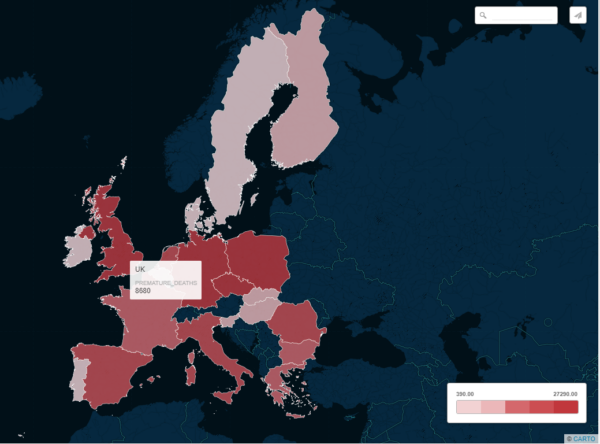How weak EU coal pollution rules could cause 71,000 deaths

Europe’s proposed air emission standards could cause thousands of premature deaths and cost billions of euros — because they are too weak.
According to a new study by environmental economist Mike Holland, the EU’s draft power plant pollution regulations – called BREF – could lead to 71,000 avoidable deaths in the decade after 2020 because the currently proposed standards do not require adoption of the latest, most effective techniques.
The actual figure is likely to be lower as the model assumes the EU coal plants covered in the study (which looks at the latest available data between 2010-12) remain open.
The analysis comes two months after Unearthed revealed that the energy industry was disproportionately represented in the EU technical working group that helped write BREF; more than half of the group’s 352 members were found to have ties to the industry.
That same report suggests that the resulting rules and regulations may actually lead to less stringent air emission standards than than those that have already been introduced – and are now being enforced – in China, Japan and the United States.
The new regulations have even angered some in the industry — who had already invested in the latest technology for improving the quality of emissions before the draft was diluted.
Documents acquired by Unearthed via Freedom of Information have revealed that European energy giant EON wrote to the UK’s Environment Agency in 2013 to express “great disappointment and frustration” at the watered-down regulations.
‘Best available technique’ Reference document.
It sets out different environmental performance standards for big industrial plants including coal and lignite plants.
It will likely be adopted in early 2016 ahead of EU-wide implementation by 2020.
Health impacts
Poorly regulated power plant emissions could also trigger respiratory conditions such as bronchitis and asthma for more than 200,000 children — the group most likely to be harmed by coal-fired health hazards.
Prolonged exposure to toxic particles (PM2.5) has been found to increase risk of stroke, heart disease and lung cancer. Emissions of sulphur dioxide (SO2), nitrogen oxide (NOX), and particulate matter – all of which are released in the coal plant smokestack – are key contributors to PM2.5. Coal-fired power plants are also the largest source of air emissions of toxic mercury (Hg) which can harm the mental and neurological development of tens of thousands of foetuses and babies in Europe.
The study, commissioned by Greenpeace and the European Environment Bureau, also argues that the combination of healthcare costs and sick days for those affected by Europe’s excess emissions is projected to cost the continent more than 50 billion euros over the course of the decade, based on figures used by the European Environment Agency.
Best available techniques
The report by Dr Holland compares the air emission standards proposed by the BREF draft to best available techniques already in use around the world.
Holland used the difference in standards to model the health and financial impacts of 290 large fossil fueled power plants around Europe at which BREF regulations would be enforced.
A small number of the coal plants used in the study have already been closed.
As the graphs above illustrate, there’s a remarkable difference between what can be done and what the EU is asking to be done.
Using the best available techniques the regulations were designed to reflect, European industrial plants larger than 1000 MWth should be able to meet SO2 emissions caps 13x more stringent than what BREF requires.
The techniques available to lignite plants to limit NOX emissions are more effective than those that hard coal plants can use, and yet BREF would allow lignite plants to release more — an amount which the actual BAT could cut in three.
Germany, home to the world’s largest lignite sector, would have the largest excess emissions due to the weak air pollution regulations, with excess emissions projected to cause more than 27,000 premature deaths projected to occur in the 2020’s.
8,000 UK deaths
Coal-fired power plants in Poland, which has a behemoth coal sector, could cause around 12,500 avoidable deaths, according to the report.
And more than 8,000 people could as as a result of excess emissions from coal-fired power plants in the United Kingdom if BREF is not adequately beefed up.
Germany will likewise take the greatest financial hit, losing 20 billion euros over the course of the 2020’s.
The UK could lose equivalent to 8.5 billion euros — if the studies cost estimates prove correct and plants remain open.

